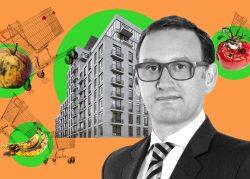Multifamily developer Sam Eshaghoff likes to eat healthful food. But in some parts of New York City, he has a difficult time finding any.
“You go to some neighborhoods and there’s no shops,” Eshaghoff said. “It’s not a matter of you’re not looking hard enough. It’s that it doesn’t exist.”
Sometimes the best he can do is a single piece of fruit.
“I can’t tell you how many times I’ve been in East Flatbush or up in the Bronx and I’m starving and I need some form of a lunch and I gravitate to whatever the healthiest option is around, and sometimes that means going to a bodega and eating a banana.”
He added, “I feel bad for the people who live there because they’re trapped, prisoners to their living conditions. They have no escape.”
To address the issue, the city in 2009 launched the Food Retail Expansion to Support Health program, or FRESH. Officials credit it for 30 new grocery stores and 21 in development since its inception, which is at best a modest number over 15 years for a city of New York’s size.
Under FRESH, in most of the city’s communities of color, developers can get additional floor area, a taller height limit and tax incentives for projects with markets that sell healthful food. The city offers up to 20,000 extra residential square feet beyond the usual zoning — one square foot of apartment for every square foot of supermarket.
A building qualifies if it provides at least 5,000 square feet of retail space “for a general line of food and nonfood grocery products intended for home preparation, consumption, and utilization,” with at least 30 percent of that space for perishable goods and at least 500 square feet for fresh produce.
The terms are more lenient now than in 2021, when the minimum was 6,000 square feet and 50 percent for perishable goods, plus regulations on frontage and signage. The terms were relaxed and eligible areas were added during the de Blasio administration because after 12 years, only 27 buildings had qualified and just eight of their supermarkets had opened.
In a city with 5,700 to 10,000 stores that sell groceries, depending on how you count them, that’s a pittance. But Mayor Eric Adams, like his predecessors Michael Bloomberg and Bill de Blasio, has nonetheless touted FRESH as a success.
“Making New York City healthier and more equitable are two central goals of our administration, and the FRESH program is accomplishing both by bringing greener and healthier supermarket options to 1.2 million New Yorkers,” Adams said in a 2023 press release.
Supporters of FRESH point to the number of properties that have used the program, but no one knows how many of those supermarkets would have opened without the tax break.
It is also unclear whether they have improved the health of local residents.
“Studies conducted over the past decade confirm that new or upgraded supermarkets rarely
disrupt shopping patterns or improve indicators like body mass index,” one CUNY study reported.
New supermarkets may improve perceptions of food access but do not appear to change the way people shop or the balance of nutritious and unhealthful items they consume, the study added.
There are several reasons why FRESH’s impact on health is likely marginal at best.
For one, “food deserts” are a small part of the problem, according to Nevin Cohen, an associated professor and director of the Urban Food Policy Institute at the City University of New York.
“In New York City, food is available in most neighborhoods,” Nevin said. “There are supermarkets throughout the five boroughs. There are very few neighborhoods that have a scarcity of grocers. The real issue here is affordability and poverty.”
Another issue is that a supermarket might not be affordable for low-income families in a high-income neighborhood. Cohen cited a study that showed that supermarket prices vary widely, even within the same chain. The cost of a basic set of goods at Key Foods ranged from $15 to $35, for example.
“People on limited incomes are very price-sensitive and they shop for sales,” he said. “They use circulars to shop, but a low cost may be a long walk or bus ride away.”
In gentrified neighborhoods like Chelsea, supermarkets are priced to affluent consumer bases, which burdens local residents of public housing, Cohen noted.
Food delivery services, and the ability to use SNAP benefits with them, have also made the term “food desert” more antiquated, or at least less relevant, he said.
Cohen says a couple of things can be done to close the gap of fresh food access and affordability.
The FRESH program’s tax benefits could be made contingent on supermarkets’ price levels, sparking interest from affordable grocers such as ALDI and Trader Joe’s, he said.
Also, reducing housing costs for low-income New Yorkers would allow them to buy more healthful food. Affordable housing has a more direct impact on health than the presence of a supermarket nearby.
Read more



The city could allow food retailers to lease ground-level space at discounts in Housing Authority properties, Cohen said, giving smaller markets the opportunity to open in places they otherwise wouldn’t.
“NYCHA developments should be the Council’s highest priority,” the CUNY study said. “Research shows that NYCHA residents have among the city’s highest rates of diet-related disease.”
Eshaghoff, the developer, suggested incentivizing fast-casual restaurants to open where they otherwise wouldn’t.
“After all, even in food-rich neighborhoods, people are getting their share of nutritious lunches and dinners from the Sweetgreens and Dig Inns of the world,” he said. “That’s the way the world is trending — people need health and convenience.”
